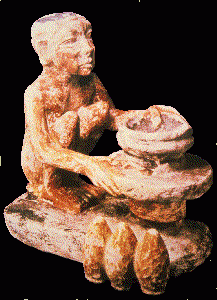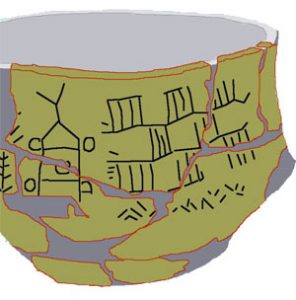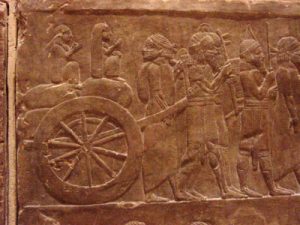
An Egyptian potter uses a pottery wheel, about 2000 BC. He uses his hand to spin the wheel.
Wheels do not exist in nature, and no animals use them except people (though some animals do use gears, which are a special kind of wheel). People didn’t use wheels until the Neolithic, about 10,000 BC – later than the other simple machines (the lever and the inclined plane). Wheels on carts appeared in the early Bronze Age, around 3500 BC,
What was happening in 10,000 BC?
Other simple machines
All our physics articles
Who invented the wheel?
The earliest evidence for people using wheels (as Elizabeth Barber points out) is the spindle whorl, and the earliest axles are the wooden spindles on to which women slid their spindle whorls.
History of spinning

Hand spindles with whorls
People around the world were certainly using spindle whorls by the Neolithic, about 10,000 BC., though it could be much earlier. Possibly (as Ian Gilligan suggests) it had something to do with the end of the last Ice Age about this time. In any case the principle of the wheel is there: the spinning creates a mechanical advantage so you can spin more thread faster.
The pottery wheel
A step forward for wheels comes from Sumeria (modern Iraq), about 4000 BC, just about the time when people first began to live in cities. The earliest wheels were probably not wagon wheels, but pottery wheels. Soon after that, though, maybe around 3700 BC, people in Central Asia were making wagon wheels. Spokes developed later than solid wheels.
(More about Central Asian inventions)

A clay pot with a drawing of a wheeled cart from what is now Poland, about 3500 BC
Wheel and axle
Wheels help people do work in two ways. First, like levers or inclined planes, wheels allow you to do something easy for a longer time, instead of doing something hard for a shorter time.
(More about levers)
If you turn a large wheel fixed to an axle, the axle will also turn. You can turn the large wheel easily (but it takes a lot of turning to go all the way around). The axle will go around a much shorter distance, but with more force.
In fact, a wheel is a kind of first-class lever. The center of the axle is the fulcrum of the lever. The outer edge of the axle is the weight of the lever. And the outer edge of the wheel is the force pushing the lever (Often, that’s the friction with the ground. On a potter’s wheel, that’s the hand of the potter pushing the wheel.)

Wheeled wagon carrying prisoners of war(Nineveh, Iraq, 700 BC)
(More about first-class levers)
Mechanical advantage
So you can use a wheel to create a mechanical advantage – you can turn something heavy, by spinning a large wheel attached to an axle that is attached to the heavy thing. That’s how a pencil sharpener works.
Or, you can do it the other way around – use a lot of force to turn the axle, and that will spin the wheels really fast. That’s what cars do, and spinning wheels.
(More about spinning wheels)

A wooden spinning wheel
You get more mechanical advantage with bigger wheels and thinner axles. The mechanical advantage of a wheel and axle is the ratio of the radius of the wheel to the radius of the axle. But bigger wheels and thinner axles are also more likely to break, so you have to find the best proportion for your specific use.
When bicycles were first invented, bicycle manufacturers had to figure out the best proportions for the wheels. Some early bicycles had one enormous wheel and one tiny wheel. Others had both wheels the same size, the way ours do today.
(More about bicycles)

How is this a wheel?
Wheels reduce friction
Also, wheels on a wagon only touch the ground at one spot at a time, keeping the rest of the wagon off the ground. This makes less friction, so that the wagon is easier to move than if you were pulling it along like a sled.
Wheels are the most important part of pottery wheels, wagons and cars, but also of wheelbarrows, spinning wheels, water wheels, windmills, and pulleys.

A machine that uses gears: a model of an Indian cotton gin (1100s AD)
Gears – a special kind of wheel
A gear is a special kind of wheel with teeth that fit into the teeth of another wheel. So a gear is also a kind of lever, because wheels are a kind of lever. Some kinds of grasshoppers have evolved to have legs with gears in the joints to jump with.
Whoever invented gears, the idea spread quickly: Indians were using gears for waterwheels by the 300s BC. Greeks knew about gears by the time of Aristotle, about the same time, and people were also using gears in China. By the early Middle Ages, people all across Afro-Eurasia were using gears to run watermills and windmills.
Learn by doing – build a windmill to generate electricity
Bibliography and further reading about simple machines:





hi
Preferably more examples
Thanks for the suggestion! I’ll work on that.
very helpful thank you karen
Wonderful! I’m glad I could help.
so lame
Sorry we couldn’t help you. What were you trying to find out?